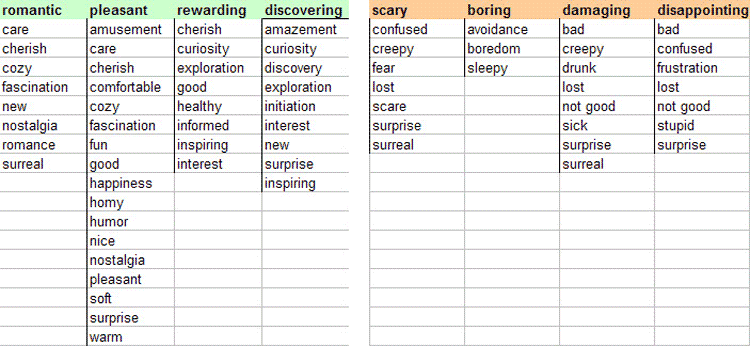
Last week's post placed a question on how the project would transform the experiences in actionable knowledge,
and I was struggling with this idea, because it did not seem to fit. Then I questioned this idea. Is all valuable know-
ledge actionable? Are there other kinds?
I introduce then the idea of Contemplationable Knowledge. It doesn't translate in action, but in other ways of seeing,
of contemplating what is around you. And maybe inside. Like in the Spanish movie later north americanized into Vanilla
Sky: Abre los Ojos - Open your eyes.
To me that's more than a valuable endeavour, it's a necessary one. And what better than maps to carry this information?

This last week I transcribed all the stories from the interviews and went through them extracting the elements, words,
activities and feelings that will make possible to categorize them into groups. The 2 hours of video were transformed in
6000 words of texts and 51 "experiences". Thanks a lot to all of you who shared them with me.
There are several elements that can be extracted from the stories that can be connected to map entities. It's a true
knowledge representation work, and ideally this should be by in a Natural Language Processing system, but still
this technology is not ready to perform satisfactorily.
The categories defined were: title, location, location type, landmarks mentioned, season,, time, weather, kind, good/ bad,
feelings, impressions, benefit, activity, number of people, nature / urban, senses, repeatable?, memory / wish, particularity

Once the data is distributed, I can infer and identify some structure:

And then cluster:

The intention behind this structure is organize the data in the ways that can be interesting to combine, allowing for
flexible manipulation and interesting parallels with traditional mapping legend. Structuring this legend will help me
visualize the system structure. That's the task for next week.


Paths ::
This week I also developed more the concept of the path, making it more graphical so that I can understand it better and
explore the possibilities in the map.


How Maps Work: Representation, Visualization and Design. By Alan M. MacEachren
Mapping Time and Space: How Medieval Mapmakers viewed their world. By Evelyn Edson
Information Graphics: Innovative Solutions in Contemporary Design. By Peter Wildbur and Michael Burke